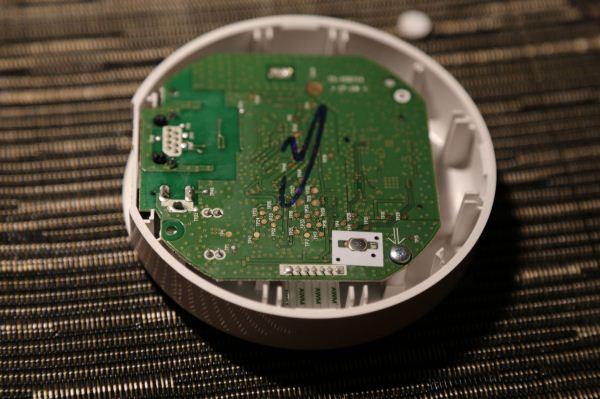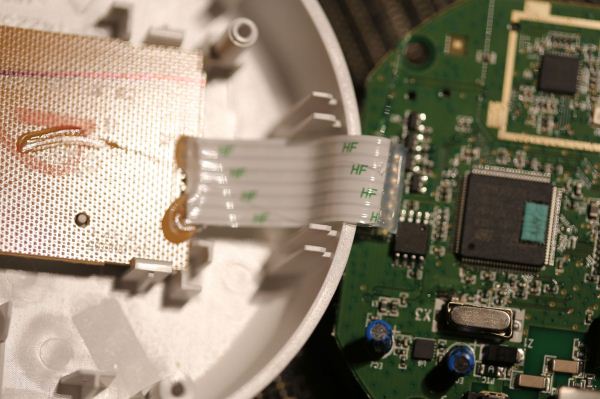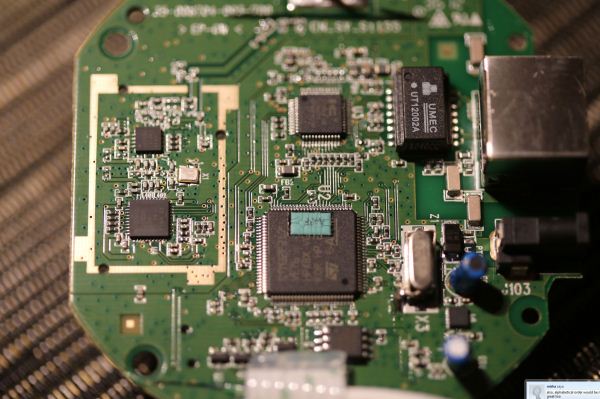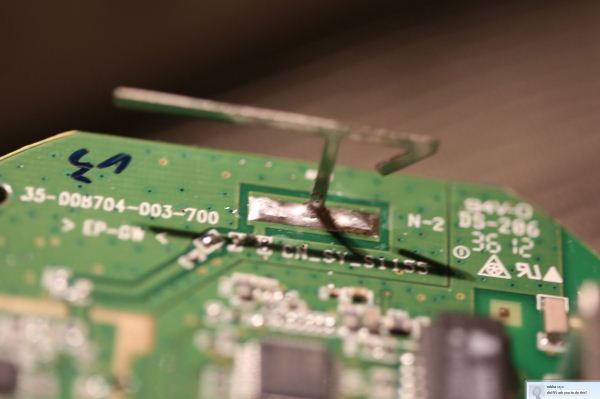Philips Hue: Automated Home Lighting Gets Colorful
by Ashu Joshi on March 1, 2013 12:50 AM EST- Posted in
- Gadgets
- Home Automation
- Philips
- Hue
- Lighting
Teardown and Design
The Hue Bridge has two screws that you need to remove before you can pop off the back. Even with the screws out, popping the back off is tricky—it has an interesting snap-in mechanism. Here’s what the back looks look like; the two white “feet” at the bottom are covering the screws. I used tools from iFixIt to get this open.
Once you open it up, you can see the back side of the PCB, and the snap-in connecter I mentioned earlier.
The PCB is connected to the front of the Bridge using a ribbon connector. This cable provides the power and signals for the LEDs and the Link button.
The main PCB has the two primary components of the Hue Bridge, an ST Microelectronics STM32F217VE Microcontrollerand a Texas Instruments CC2530 ZigBee Controller.
There is also an RF range extender (CC2590) coupled to the CC2530. The STM MCU has an integrated Ethernet controller, but as a whole the design has very few components. It’s clear that the majority of the cost for the Starter Pack is in the bulbs and not in the Bridge. (Based on the total kit price, the Bridge is $20 more than the cost of the three bulbs, though of course that leaves plenty of room for profit margins.) The image below shows the antenna for ZigBee:
I’ll cover the technology behind the Hue Bridge in a moment, but the choice of microcontroller for this design is a clear indication that this is primarily a purpose-built device. That is, it does not have the horsepower to extend to different types of applications due to the limitations of the CPU and the amount of memory. Nonetheless, it is well suited for the function at hand; let’s look at the specifics of the technology behind Hue before we get into a discussion of what it can and cannot do.





















94 Comments
View All Comments
Lord 666 - Friday, March 1, 2013 - link
Ok Super Sleuth. On your LinkedIn, does it say you work for the CIA, NSA, or Mossad?Egg - Friday, March 1, 2013 - link
None of those.I'm in high school.
BrokenCrayons - Friday, March 1, 2013 - link
Oh look a new person posting reviews at Anandtech. Let's be big meanie-heads right away instead of saying hi and welcoming someone who's just getting started. That won't make them jaded or plant the seeds that cause them to feel subversively belligerent toward the readers.I, for one, am happy to say, "Welcome Ashu! It's great to see someone new and we look forward to reading your work in the future," even if some people are having a case of the internet grumpy-wumpies.
Egg - Friday, March 1, 2013 - link
I didn't comment on this article - at two in the morning - to flame, troll, deface, or hate on Anandtech. I don't think you can accuse me of that, if you look at my language. If you're somehow offended by "a bit deceptive," "I'm not sure how I feel," and "I don't see Brian Klug posting his reviews on his blog," I apologize. Yet I see far, far, worse elsewhere on this site.So why did I write a comment, when I should have been studying for a test the day after?
I've been a reader of many, many, tech websites: Tom's Hardware, HardOCP, The Verge, Engadget, Silent PC Review, techpowerup, AndroidCentral... the list goes on.
However, there's only one tech website I've continued to read - AnandTech. I read AnandTech because they have some of the most talented people in the industry, Ashu Joshi included. I read AnandTech because it lacks sensationalism and triviality. I read AnandTech because I can be sure everything, short of typos, is correct. I do consider AnandTech to be the "New York Times" of tech journalism.
That's why I believe what is a valid point can and should be raised. Rational people can disagree on many issues, but here's a different question: isn't at least *knowing* how this article came to fruition better than not knowing? As readers who I like to think are a cut above those of other tech sites, we shouldn't simply ignore these details.
Galidou - Saturday, March 2, 2013 - link
''I didn't comment on this article - at two in the morning - to flame, troll, deface, or hate on Anandtech''No one said so.
''I don't see Brian Klugs posting his reviews on his forum''
Well that's maybe becuase he's not new to anandtech...
''I do consider AnandTech to be the "New York Times" of tech journalism. ''
That's your perception, doesn't mean everyone thinks this way, proof of that, someone commented on the fact that this isn't the New york times.
''Rational people can disagree on many issues, but here's a different question: isn't at least *knowing* how this article came to fruition better than not knowing?''
Don't think it makes that much of a difference TO ME, anandtech just gave him more visibility and now that he's working here I guess you won't see much ''duplicates'' on Ashi's blog. The knowledge you tried to add here didn't cut it. Proof of it, most of the replies you had were negatives.
Galidou - Saturday, March 2, 2013 - link
Typo error: Ashu's blog :)JarredWalton - Saturday, March 2, 2013 - link
Just to elaborate on Galidou's response, this is pretty much the way AnandTech functions if you're ever interested in writing for us. Find something you're passionate about and write about it and send it our way. If it's on your blog, that's fine. If the article happens to be about something we haven't covered, we might talk about turning it into an article for AnandTech. As an alternative, do this in the forums and we're looking at the potential for increasing forum post visibility as well.Going forward, once you start writing for AnandTech, we would expect the articles to not be posted/reposted elsewhere, so if Ashu writes about LIFX next it would be an AnandTech exclusive. I don't have a blog for example where I post my AnandTech articles, though I'll sometimes link them and I definitely link them on Facebook. But of course, most of this is up to your discussions with Anand when you sign a writer's agreement...what you're willing to do may be different than what others have agreed to.
Cheers!
Egg - Saturday, March 2, 2013 - link
"No one said so.""Haters gonna hate..."
And the tone of the other responses suggested so.
"Well that's maybe becuase he's not new to anandtech..."
So we should treat different writers with different standards depending on how long they've been writing?
If someone working for a company for 1 year makes the same mistake as someone working for the same company for 20 years, yes, the rookie probably gets off the hook more easily. But they both get their mistakes pointed out just the same.
"That's your perception, doesn't mean everyone thinks this way, proof of that, someone commented on the fact that this isn't the New york times."
Yes, I realize that, that's why I mentioned my opinion that AnandTech is the New York Times of tech journalism. By saying otherwise, you're essentially saying that AnandTech shouldn't have the highest standards possible. Something which AnandTech's About page doesn't seem to support:
"You support us by simply reading the site and we owe it to you to do the best job possible. Our loyalty is ultimately to the readership and not treating you like idiots is the first necessary step to holding up our end of the deal."
"Proof of it, most of the replies you had were negatives."
Voluntary response always holds tremendous bias.
JonnyDough - Tuesday, March 5, 2013 - link
That's all online journalism usually is. Plagiarism. Most blokes online don't even have degrees. People with an education get real jobs!Bladen - Friday, March 1, 2013 - link
Whom is coping whom?Phillips, or LIFX?
http://www.kickstarter.com/projects/limemouse/lifx...